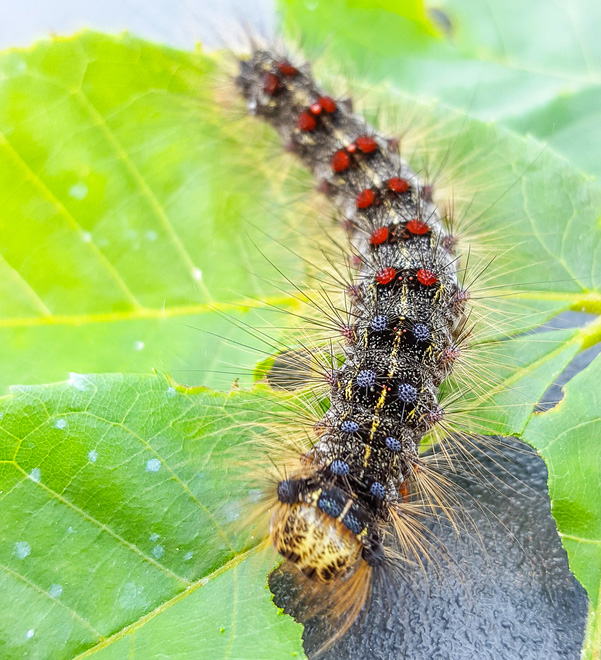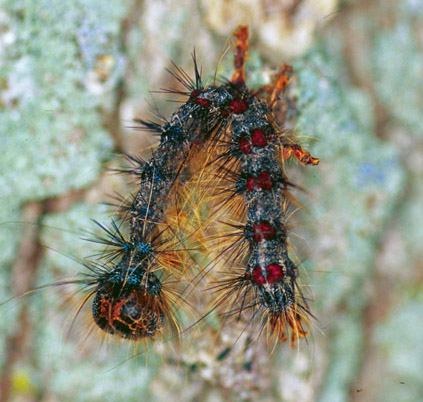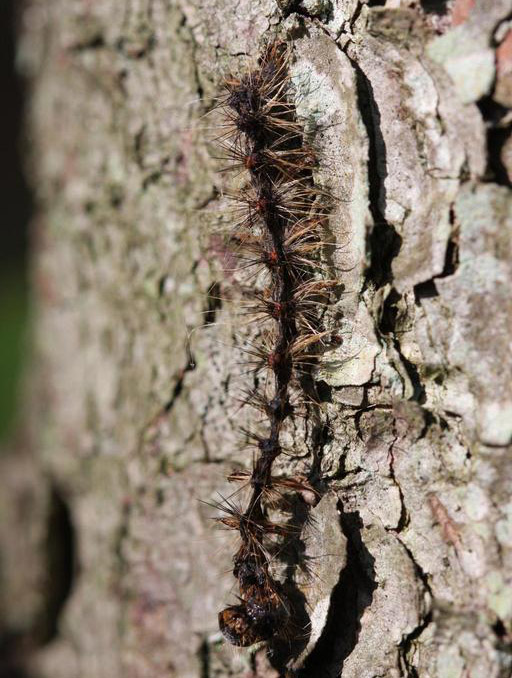A Virus and a Fungal Disease Cause Spongy Moth Outbreaks to Collapse
April 27, 2022 - Deborah McCullough
Spongy moth (Lymantria dispar, formerly gypsy moth) is an exotic pest established in Michigan since the 1980s. Caterpillars, the immature “larval” stage, feed on the leaves of oaks, aspens and many other trees in landscapes and in forested areas. During Lymantria dispar outbreaks, caterpillar density can be so high that some trees may be completely stripped of leaves by mid-summer. Fortunately, defoliation caused by spongy moth caterpillars rarely kills trees. The large, hairy caterpillars, however, often annoy people living or recreating in areas where an outbreak is underway.

Outbreaks of spongy moth populations usually collapse after two to four years. This is partly because of the natural enemies that attack spongy moth eggs, caterpillars or cocoons. Natural enemies include predators such as white-footed mice, certain birds and predatory insects or mites. Parasitoids, which are highly specialized wasps or flies, can attack spongy moth eggs, larvae and cocoons.
Two diseases that affect spongy moth caterpillars are the most important factors causing outbreaks to collapse. One disease is a nucleopolyhedrosis virus (NPV) while the other disease is a fungus called Entomophaga maimaiga.
NPV – the spongy moth virus
Spongy moth populations in North America have always been affected by NPV. Because the virus is present in spongy moth populations, it does not need to be introduced. Some spongy moth will carry a sublethal load of NPV that affects their health but doesn’t cause mortality. Female moths, for example, are smaller and produce fewer eggs when they have a sublethal dose of NPV.
Generally, NPV causes high levels of caterpillar mortality when the spongy moth population is at very high densities – e.g., an outbreak. During outbreaks, spongy moth caterpillars must compete for food (leaves) and resting space. This stress increases their vulnerability to NPV. Often, a NPV epizootic occurs during the second or third year of an outbreak. In an epizootic, many caterpillars die over a short period of time. Caterpillars killed by NPV typically hang limply from the trunk or a branch in an upside down V-shape. The cadavers liquefy and disintegrate rapidly, and will produce a foul odor when handled.


Entomophaga maimaiga – the spongy moth fungus
The second disease, Entomophaga maimaiga, is a fungus native to Japan. In Latin, Entomophaga means “insect eater” and maimaiga is the Japanese name for spongy moth. This fungus was originally introduced into the northeastern United States in the early 1900s as a biological control for spongy moth. It was released in Michigan in 1991 when much of Lower Michigan experienced the first major spongy moth outbreaks.
Thick-walled "resting spores" of E. maimaiga are present in the soil or on tree bark during winter. If moisture and temperatures are favorable, resting spores will germinate in May or June. Young spongy moth caterpillars make contact with the sticky fungal spores in spring as they search for suitable leaves for feeding. The fungus digests its way into an infected caterpillar, grows inside its body and can kill the caterpillar within a week.
A second type of spores called conidia are then produced on the cadavers of the dead caterpillars. These microscopic spores are spread by the wind and can infect and kill other spongy moth caterpillars. The cycle of conidia production and infection may occur four to nine times during summer. When the fungus kills large caterpillars, the decomposing cadavers release the overwintering resting spores back into the soil. Cadavers of large spongy moth larvae killed by the E. maimaiga fungus are stiff, dry and hang head down from the tree trunk.

Weather plays an important role in determining how effective E. maimaiga will be in a given year. Like most fungi, the spores need moisture and high humidity to germinate. Frequent rainfall during May and June can contribute to developing E. maimaiga epizootics during spongy moth outbreaks.
The dynamics of the two diseases differ. The spongy moth NPV is not affected by spring rainfall or temperatures, but is seldom prevalent until spongy moth populations reach very high levels. In contrast, E. maimaiga may kill spongy moth caterpillars even when populations are low, but only if weather conditions are favorable. Both diseases may occur in the same spongy moth population, especially during outbreaks.



 Print
Print Email
Email





